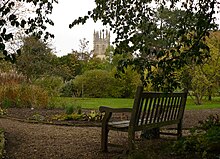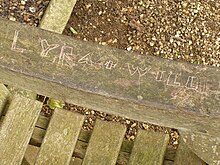The Amber Spyglass
OCLC 55870599 | | |
| Preceded by | The Subtle Knife | |
|---|---|---|
| Followed by | Lyra's Oxford | |
The Amber Spyglass is the third and final novel in the
In 2022, the novel was adapted as the third series of the joint BBC-HBO television series His Dark Materials.
Setting
The novel is set in a number of worlds dominated by the Magisterium, a theocracy which actively suppresses heresy. In some of these worlds, humans' souls naturally exist outside of their bodies in the form of sentient "dæmons" in animal form. Important plot devices are the alethiometer, a truth-telling symbol reader; the subtle knife, capable of cutting windows between worlds; and the amber spyglass, a device for viewing the form of consciousness known as Dust.
Plot
Having learned of the witches' prophecy that
In the world of
The physicist Mary Malone finds herself in a world of sapient creatures called
Will meets
Lyra and Will travel to the world of the dead. Visitors are forced to leave their dæmons behind, causing Lyra and her dæmon Pantalaimon enormous pain. Will's dæmon, previously internal, now becomes visible. After finding Roger, they persuade the harpies that control the world to allow them to open a window so the dead can leave. The dead step through and joyfully dissolve, their atoms becoming one with the universe.
Asriel's army and the forces of the Magisterium join battle. Mrs Coulter, who has allied herself with Asriel, enters the Authority's citadel, tempts Metatron, and then betrays him. Mrs Coulter, Asriel and Metatron fall into an abyss and are destroyed. Lyra and Will free the Authority from a crystal litter in which he is being carried, and find him demented and powerless – so feeble that mere exposure to the wind causes his form to dissolve.
Lyra and Will escape with their dæmons to the mulefa world, where Mary tells them of her own past. Before becoming a physicist she had been a nun, but had lost her faith when she had fallen in love and realised that the nun's heaven was empty. Hearing her words, Lyra experiences new and strange sensations of her own. The next day, Lyra and Will set off to picnic in the wood. The couple kiss and confess their love for each other, and the Dust envelops them.


The witch
They return, and the witches set about closing the windows. Will deliberately destroys the subtle knife. In her own world, Lyra finds that she has lost the ability to intuitively read her alethiometer. She decides to take up the academic study of alethiometry and, together with Pantalaimon who has now taken the permanent form of a
Changes to US edition
Pullman's publishers have primarily marketed the His Dark Materials series to young adults, but Pullman also intended to speak to adults. The Amber Spyglass is partly a re-evaluation of the Biblical tale of Adam and Eve. Pullman said Lyra's sexual awakening "is exactly what happens in the Garden of Eden … Why the Christian Church has spent 2,000 years condemning this glorious moment, well, that's a mystery. I want to confront that, I suppose, by telling a story that this so-called original sin is anything but. It's the thing that makes us fully human."[3]
The North American edition alters passages describing Lyra's incipient sexuality.[3] The text in the UK edition[4] includes this passage in the chapter "Marzipan":
As Mary said that, Lyra felt something strange happen to her body. She found a stirring at the roots of her hair: she found herself breathing faster. She had never been on a roller-coaster, or anything like one, but if she had, she would have recognised the sensations in her breast: they were exciting and frightening at the same time, and she had not the slightest idea why. The sensation continued, and deepened, and changed, as more parts of her body found themselves affected too. She felt as if she had been handed the key to a great house she hadn't known was there, a house that was somehow inside her, and as she turned the key, deep in the darkness of the building she felt other doors opening too, and lights coming on. She sat trembling, hugging her knees, hardly daring to breathe, as Mary went on...
This is amended in the US edition to:
As Mary said that, Lyra felt something strange happen to her body. She felt as if she had been handed the key to a great house she hadn't known was there, a house that was somehow inside her, and as she turned the key, she felt the other doors opening deep in the darkness, and lights coming on. She sat trembling as Mary went on...
Other passages have also been modified in the US edition.[5]
Chapter headings
Each chapter carried at the beginning a quotation from one of Pullman's favourite authors, including Milton (Paradise Lost), William Blake and Emily Dickinson.[6] Before His Dark Materials first came out the publisher had asked Pullman to produce his customary drawings for the head of each chapter, his drawings first appeared in the Lantern Slide editions of the books.[7]
Critical reception
The Amber Spyglass won critical acclaim and became the first children's book to win the
Michael Dirda praised The Amber Spyglass as "an expertly paced and orchestrated novel." He notes Pullman's allusiveness: "In his acknowledgments Philip Pullman admits he has stolen material 'from every book I have ever read.' Besides finding hints of Paradise Lost and Blake's poetry, the astute will pick up echoes of the following: Christ's harrowing of hell, Jewish Kabbalah (the legend of the godlike angel Metatron), Gnostic doctrine (Dust, our sleeping souls needing to be awakened), the 'death of God' controversy, Perelandra, the Oz books (the Wheelers), Wagner's Ring of the Nibelungs (Siegfried's mending of the sword), Aeneas, Odysseus and Dante in the Underworld, the Grail legend and the wounded Fisher King, Peter Pan, Wordsworth's pantheistic 'Immortality Ode', the doctrine of the hidden God and speculation about the plurality of worlds, situational ethics (actions, not people, being good or bad), the cessation of miracles, Star Wars...and even Pullman's own early novel for adults, Galatea." He concludes by writing that "His Dark Materials is a novel of electrifying power and splendor, deserving celebration, as violent as a fairy tale and as shocking as art must be."[8]
In 2019, it was ranked sixth in The Guardian's list of the 100 best books since 2000.[9]
TV adaptation
The third series of the joint BBC-HBO television adaptation of His Dark Materials, released in December 2022, mainly covers The Amber Spyglass.
Audiobook
An audiobook version narrated by Pullman and with a full cast was released in 2001.[10]
References
- ^ Gibbons, Fiachra (23 January 2002). "Epic children's book takes Whitbread". The Guardian. London. Retrieved 5 April 2007.
- ^ Reynolds, Nigel (23 January 2002). "Children's book scoops £30,000 Whitbread prize". The Daily Telegraph. London. Archived from the original on 1 January 2021. Retrieved 9 October 2008.
- ^ The Atlantic Monthly. The Atlantic Monthly Group. Retrieved 11 February 2014.
- ^ Corliss, Richard (8 December 2007). "What Would Jesus See?". Time. Archived from the original on 10 December 2007. Retrieved 4 May 2008.
- ^ "The Republic of Heaven • View topic". US edited versions?. 29 November 2007. Archived from the original on 1 January 2021. Retrieved 23 October 2018.
- ^ "Pullman Pullman His Dark Materials | the Amber spyglass | Read an extract from the Amber Spyglass". Archived from the original on 4 October 2011. Retrieved 20 September 2011.
- ^ "Illustrations". Philip Pullman. Archived from the original on 1 January 2021. Retrieved 1 February 2020.
- W. W. Norton.
- from the original on 6 December 2019. Retrieved 8 November 2019.
- ^ "THE AMBER SPYGLASS by Philip Pullman Read by a Full Cast | Audiobook Review". AudioFile Magazine. Retrieved 28 May 2023.
- Lenz, Millicent (2005). His Dark Materials Illuminated: Critical Essays on Phillip Pullman's Trilogy. Wayne State University Press. ISBN 0-8143-3207-2.
- Frost, Laurie (2006). The Elements of His Dark Materials. The Fell Press.
External links
- Philip Pullman Author's website
- HisDarkMaterials.com Publisher Random House's His Dark Materials website
- Scholastic: His Dark Materials UK publisher's website
- Randomhouse: His Dark Materials U.S. publisher's website
- BBC Radio 4's His Dark Materials site inc. Dictionary of His Dark Materials and web Q&A with Philip Pullman
- The then Archbishop of Canterbury and Philip Pullman in conversation at the National Theatre, from The Daily Telegraph
